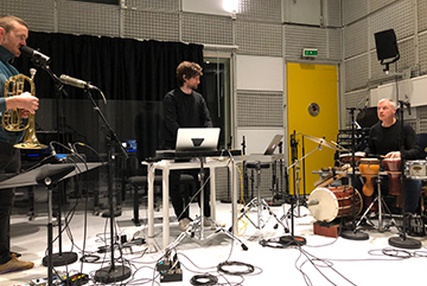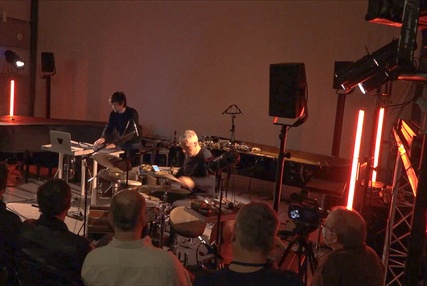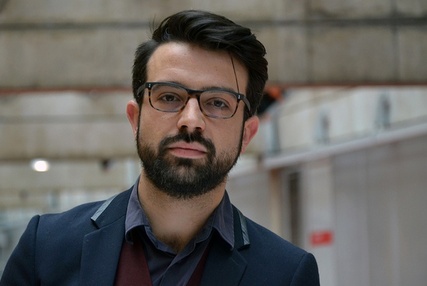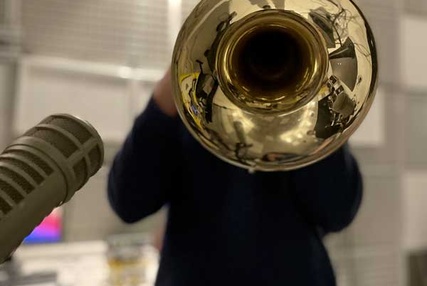La résidence en recherche artistique de Maxime Mantovani est organisée autour de deux axes : l’un logiciel, autour d’une IA de synthèse audio en temps réel et l’autre matériel, pour concevoir une interface de contrôle permettant d’interpréter véritablement ladite synthèse de manière quasi organologique ou du moins kinesthésique – comme n’importe quel instrument de musique. C’est à cette interface que nous nous intéressons dans ce dernier volet de notre série…
La première chose qui saute aux yeux sur cette interface, ce sont les quatre disques, qui tiennent autant de la platine de DJ que du cadran de téléphone. L’interface est conçue pour contrôler un patch particulier dans le logiciel Max, ou à tout le moins certains paramètres du patch (choisis par le musicien). « J’ai pensé cette interface pour être à la fois sur mesure et évolutive, explique Maxime Mantovani. Je n’ai pas toujours besoin de tous les boutons pour l’instant, mais j’ai anticipé de futurs développements. L’idée est que quelqu’un d’autre pourrait la reprendre et la refaire à sa main : le protocole de communication Open Sound Control est standard, et permet d’envoyer les informations à l’ordinateur. Pour moi, cet objet est un héritage de la musique concrète, et sa philosophie générale s’inspire des méthodes de pionniers de cette musique, qui manipulaient les bandes magnétiques pour agir de manière concrète sur le son. »
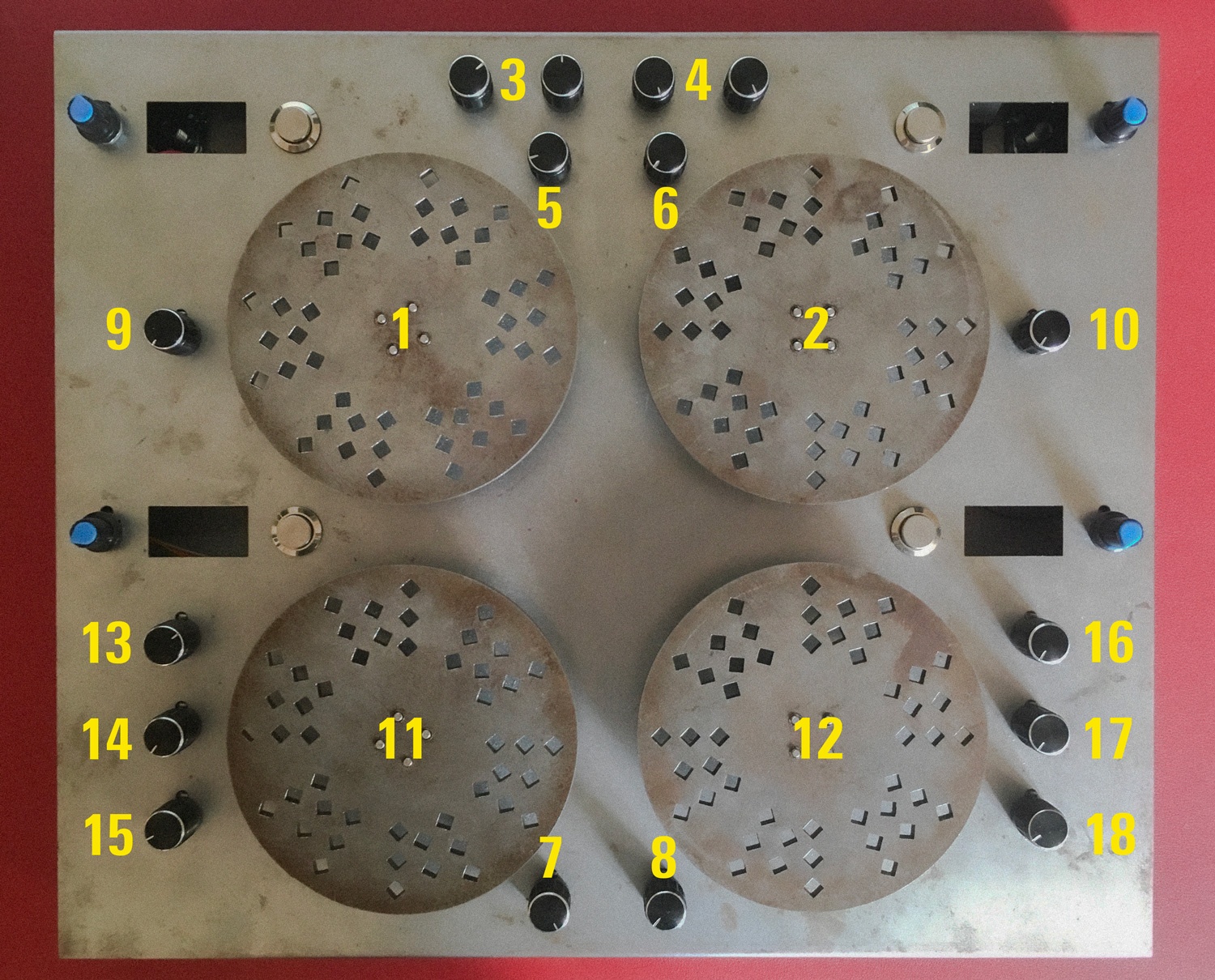
L'interface vue d'en haut — description des éléments ci-après
La partie haute
Les disques (1) et (2)
Les deux disques en haut de l’interface contrôlent les têtes de lecture de deux modules de synthèse granulaire MuBu Granulate (développé à l’Ircam par l’équipe ISMM) à partir de sons qui peuvent être générés par un moteur IA.
« Un module MuBu génère du son en permanence, mais on ne l’entend que lorsque je tourne le disque. Et plus je le tourne de manière énergique, plus le son sera fort et prégnant : le jeu sur le disque permet donc de gérer la dynamique et la prégnance du son, en même temps que sa durée. Combiner plusieurs paramètres sur un seul contrôle est particulièrement intéressant, puisque les gestes instrumentaux gagnent en complexité et la génération du son en richesse. Exactement comme un archet de violon : l’entrée en vibration de la corde semble simple, et pourtant les modes de jeu sont infiniment complexes, selon que l’on joue sur le poids, la vitesse, la longueur, l’épaisseur de mèche… »
Les potentiomètres (3) et (4)
Les quatre potentiomètres situés au-dessus des disques permettent d’ajuster les paramètres de la synthèse granulaire du module Mubu : durée d’un grain, période, etc.
Les potentiomètres (5), (6), (7) et (8)
Ces potentiomètres permettent de régler l’incrémentation des têtes de lecture : c’est-à-dire la vitesse de déplacement dans un fichier son pour un même geste, un peu comme les rapports de vitesse sur un vélo ou une voiture.
Les potentiomètres de part et d’autre des disques (9) et (10)
Les modules Mubu générant du son sans arrêt et la rotation du disque lançant la lecture, ces potentiomètres permettent de gérer le début et la fin du son, la « rampe d’enveloppe » dans le jargon. L’attaque et la désinence. Réglée au minimum, l’attaque est très franche (le volume passe de 0 % à 100 % en 10 ms et inversement), réglé au maximum, le son apparaît et disparaît en 2 secondes.
« Ça me permet de jouer sur le phrasé et la résonance », dit Maxime Mantovani.
La partie basse
Les disques (11) et (12)
Ces disques-là contrôlent ensemble un module Looper CSound (qui permet de réaliser et de jouer des boucles sonores). L’un des deux permet de se déplacer au sein de l’échantillon pour choisir le début de la boucle, et le deuxième gère la vitesse de lecture de la boucle.
« Exactement comme sur un REVOX, je peux pousser très haut en vitesse ou ralentir à l’extrême. A contrario du REVOX, les vitesses peuvent être poussées jusqu’à une forme de saturation numérique qui devient musicale. »
Les potentiomètres (13), (14), (15), (16), (17) et (18)
Pour l’instant, seul le (16) a une fonction : celle de contrôler la fenêtre de lecture du Looper.
Les autres auront sans doute des fonctions dans le futur.
Les écrans de contrôle
Dans leur état normal, les quatre écrans permettent de visualiser la forme d’onde générée par le disque correspondant. Cet affichage change dès qu’on touche à un paramètre du module concerné (paramètres de granulation, période, etc.) pour afficher la nouvelle valeur dudit paramètre.
De part et d’autre des écrans se trouvent un module encodeur rotatif et un bouton. Un « module encodeur rotatif » est un bouton tournant cranté sur des positions prédéterminées : il permet ici de sélectionner les entrées ou les sorties pour le disque concerné.
Quant au petit bouton de l’autre côté, il permet de déclencher des enregistrements – pour générer une boucle, par exemple.
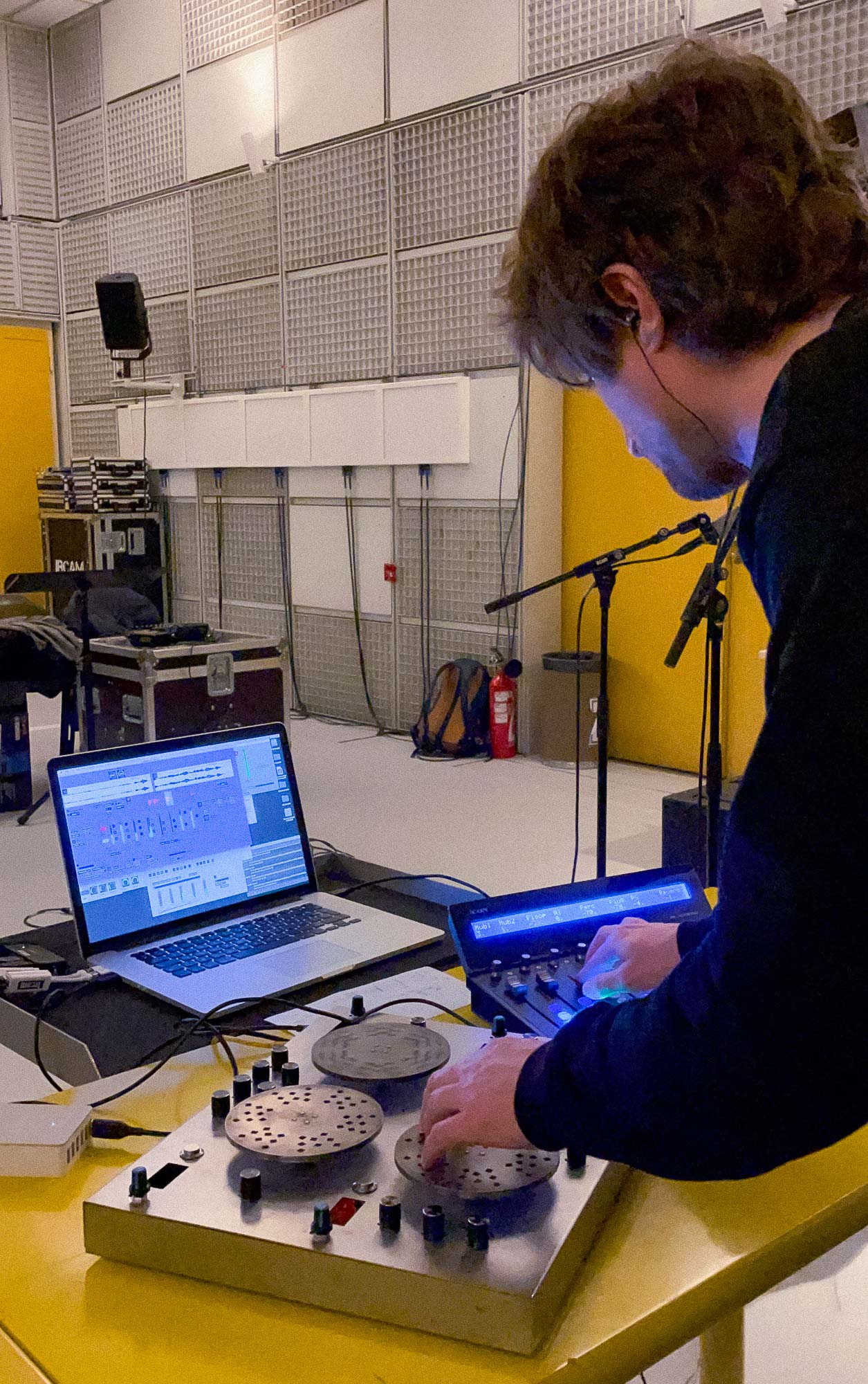 « En plus de l’interface proprement dite, j’utilise une plateforme iCon M+ – sorte de table de mixage avec divers faders, que l’on utilise généralement pour contrôler des logiciels type ProTools, mais que j’ai détournée pour qu’ils fonctionnent avec mes patchs Max. C’est ce qui me permet de contrôler mes entrées et sorties, de mixer les sons et de réaliser des traitements en temps réel, assez classique – comme une seconde couche de manipulation des sons.
« En plus de l’interface proprement dite, j’utilise une plateforme iCon M+ – sorte de table de mixage avec divers faders, que l’on utilise généralement pour contrôler des logiciels type ProTools, mais que j’ai détournée pour qu’ils fonctionnent avec mes patchs Max. C’est ce qui me permet de contrôler mes entrées et sorties, de mixer les sons et de réaliser des traitements en temps réel, assez classique – comme une seconde couche de manipulation des sons.
J’ai préféré séparer les deux : pour pouvoir adapter mon dispositif à un large éventail de projets artistiques, j’ai adopté une pensée modulaire, qui me vient aussi du mode de fonctionnement des synthétiseurs. En réalité, cette interface n’est pas une création ex nihilo : elle s’appuie sur un héritage, celui de l’histoire de la musique électroacoustique et de la musique concrète, dont j’ai fait l’apprentissage au CNSMD de Lyon, mais aussi sur des échanges d’idées dans le milieu et avec les musiciens. »
Crédit photos : © Maxime Mantovani




 « En plus de l’interface proprement dite, j’utilise une plateforme iCon M+ – sorte de table de mixage avec divers faders, que l’on utilise généralement pour contrôler des logiciels type ProTools, mais que j’ai détournée pour qu’ils fonctionnent avec mes patchs Max. C’est ce qui me permet de contrôler mes entrées et sorties, de mixer les sons et de réaliser des traitements en temps réel, assez classique – comme une seconde couche de manipulation des sons.
« En plus de l’interface proprement dite, j’utilise une plateforme iCon M+ – sorte de table de mixage avec divers faders, que l’on utilise généralement pour contrôler des logiciels type ProTools, mais que j’ai détournée pour qu’ils fonctionnent avec mes patchs Max. C’est ce qui me permet de contrôler mes entrées et sorties, de mixer les sons et de réaliser des traitements en temps réel, assez classique – comme une seconde couche de manipulation des sons.